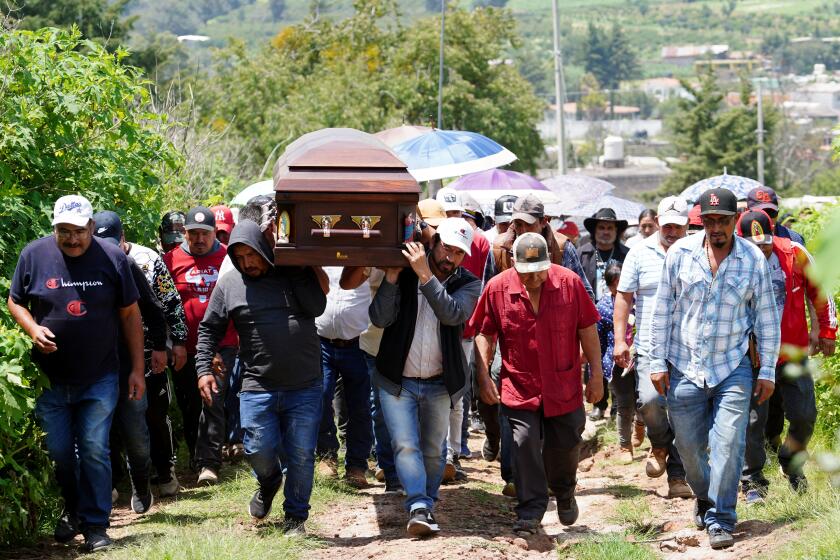The cortege wound its way up a dirt path, past well-appointed homes providing a contrast to the rock-strewn lane leading to the hilltop cemetery.
This community in the central Mexican state of Michoacán is home to about 1,500 people, many of whom make a living planting corn, plums, peaches and other crops that cut symmetrical rows through the verdant hillsides — now glistening an emerald green, the bounty of recent rains.
But the stolid brick-and-concrete residences along the rocky road are the legacy of a generation of immigrants — men such as Jaime Alanis García, who left to toil in the fields, factories and other workplaces of California, dutifully sending money back to their village to build homes and other projects.
Among the works financed via immigrant remittances is the chapel of Our Lady of Guadalupe, where a funeral Mass was held Saturday, for Alanis García.
He is the first known fatality tied to the Trump administration’s work-site enforcement raids — in this case a pair of sweeps on July 10 through Glass House Farms cannabis facilities in California.
Residents of Huajúmbaro de Guadalupe bid their final farewell to Jaime Alanis García, who was fatally injured when he climbed atop a greenhouse and fell 30 feet while fleeing immigration agents in Camarillo. (Juan Jose Estrada Serafin / For The Times)
Alanis García, 56, was fatally injured when he fell 30 feet from atop a greenhouse while fleeing immigration agents at the Glass House site in Camarillo, relatives say. Mexican consular officials arranged for his body to be shipped back from California.
“He was like so many of us, a hardworking person who went to California to earn a living, to help his family,” said Rosa María Zamora, 70, a native of Huajúmbaro de Guadalupe, who was visiting from her home in Houston. “For us, California represented an opportunity, a chance to improve our horizons.”
A quarter of a century ago, Zamora said, she left to join her husband, a field worker in California. The pair later found employment in slaughterhouses in Nebraska, where she suffered a severe leg injury from a cutting blade.
“It’s so sad that Señor Jaime came back in this way,” Zamora said.
She was among about 200 mourners accompanying Alanis García on his doleful final journey through his hometown.
“Look how many people there are here today,” said Manuel Durán, a brother-in-law of Alanis García. He traveled here with other relatives from Oxnard, where Alanis García lived. “He was very beloved.”
Durán donned a T-shirt emblazoned on the front with stylized angel wings soaring from a photo of Alanis García. “In Loving Memory,” read the text.
The rear of the shirt featured the hashtag #justiceforJaime, in English and Spanish, reflecting relatives’ assertion that the July 10 operation was reckless. “We want justice, please,” Janet Alanis, 32, his daughter, said. “Tell everyone that all we ask for is justice.”
The U.S. Department of Homeland Security defended the raid, which authorities say resulted in the arrests of more 300 people. Authorities say that agents called in medical assistance for Alanis García, who, according to an autopsy, suffered head and neck injuries.

Residents of Huajúmbaro de Guadalupe gather for the funeral of Jaime Alanis García, whom many had not seen since he was a teenager. (Juan Jose Estrada Serafin / For The Times)
Alanis Garcia left Huajúmbaro de Guadalupe as a young man but, according relatives and acquaintances, always provided for his wife and daughter, who remained here, dependent on his earnings as a farmworker. He last visited his hometown 17 years ago, for his daughter’s quinceañera, or 15th birthday celebration, residents said.
Such protracted separations have become increasingly the norm in the decades since Alanis García first crossed as an undocumented worker into California. Stretches of the U.S.-Mexico border that once featured minimal fencing and policing have now become heavily militarized. For many undocumented immigrants, that has all but eliminated once-routine trips home to visit loved ones in Mexico.
Word of the ongoing U.S. immigration raids has seeped back to immigrant communities throughout Mexico, raising deep anxieties.
“My husband lives in Oxnard, but, thank God, he didn’t work in the place where the raid was,” said Margarita Cruz, 47, a mother of three who attended the funeral. “My husband tells me that the situation there is very difficult. There’s a lot of fear that people could get arrested.”
Her husband departed 15 years ago for California, Cruz said. He last visited four years ago.
“Here we survive thanks to the money that our husbands and sons send back from the United States,” Cruz said. “Now, everyone’s worried that they will deport our relatives. What will we do? There is no work here. Look at what happened to Señor Jaime.”
In some ways, things have worsened in many rural stretches of Mexico that have long sent immigrants to the north. The dramatic rise of Mexican organized crime has cast a shadow over much of Michoacán state, where rival gangs battle for control of drug-smuggling, extortion and other rackets.
On Friday, shortly after the much-anticipated arrival of Alanis García’s body from California, a state police officer who accompanied the remains was clearly agitated. He was anxious to leave — and warned visiting journalists to beat it out of town by sundown.
“Don’t be caught here after dark,” said the jittery cop, who brandished an assault rifle as he scanned the environs. “It’s very, very dangerous here. Two groups are fighting for control.”

Community members bid their final farewell to Jaime Alanis García in his hometown in the Mexican state of Michoacán. (Juan Jose Estrada Serafin / For The Times)
But it was peaceful Saturday, as relatives accompanied Alanis García’s body to the church, where the coffin was flanked by candles. Elaborate flower arrangements graced the pews and walls. A 12-piece band of brass, woodwind and percussion instruments provided a musical backdrop in the church patio. The musicians wore white, flower-print jackets and black shirts as they played funereal tunes.
After the Mass, men from the town shouldered the wooden casket up the hill about half a mile to the cemetery. The band kept playing as the pallbearers trudged onward. Many in the procession hoisted umbrellas against a searing midday sun.
The coffin, bedecked with flowers, was opened at a pavilion in the cemetery. A relative placed a crucifix on the chest of Alanis García. His photo looked down from inside the coffin. Mourners approached for a last look at a man whom many had not seen since he was a teenager.
Mourners gathered in praying the rosary. Those praying asked the Virgin Mary, “Queen of the migrants,” to pray for the soul of the departed.
The coffin was closed, and men lowered it into the adjacent grave. Mourners tossed individual roses into Alanis García’s final resting place. Men took turns shoveling in the reddish dirt.
Relatives say Alanis García, like so many immigrants, always wanted to return home to his family.
His distraught widow, Leticia Cruz Vázquez, wailed, “I didn’t want him like this!” before fainting. Relatives and neighbors carried her limp figure away from the crowd.
McDonnell is a Times staff writer and Sánchez a special correspondent. Special correspondent Liliana Nieto del Río contributed to this report.
This story originally appeared in Los Angeles Times.

